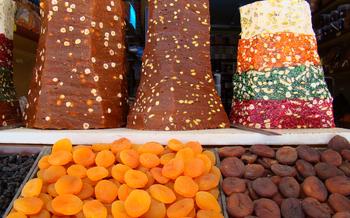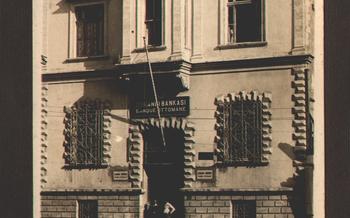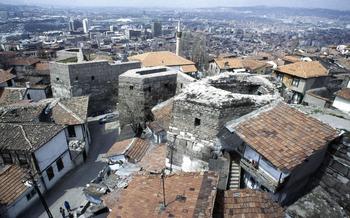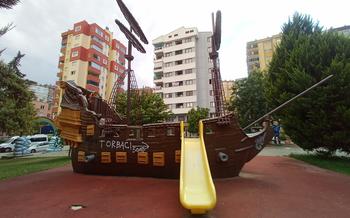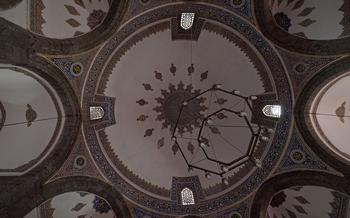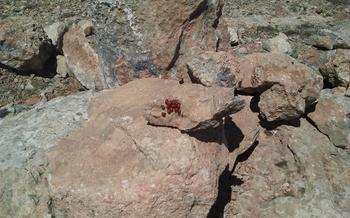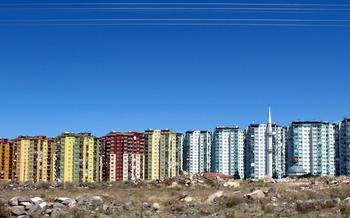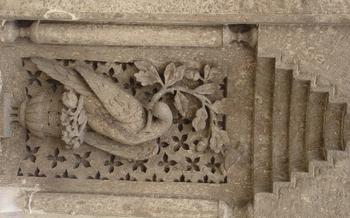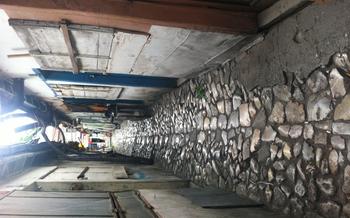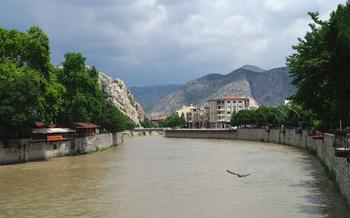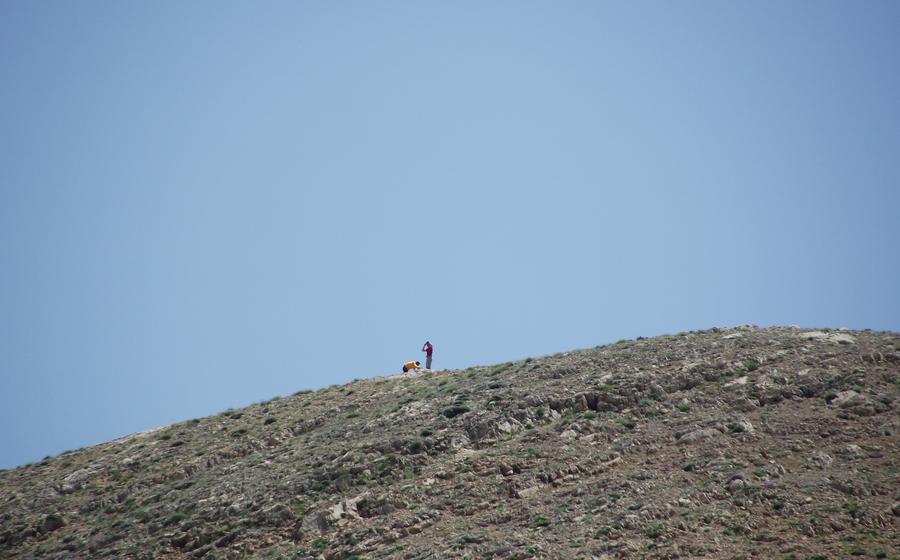
Fethiye Mosque
- Historical Significance:
- Architectural Marvel:
- Interior Splendor
- Prayer Hall and Mihrab
- Minbar and Minarets
- Dome and Arches
- Courtyard and Ablution Fountain
- Historical Context of Malatya
- Nearby Attractions
- Best Time to Visit
- Getting There and Around
- Where to Stay
- What to Eat
- Insider Tip:
Historical Significance:
The Fethiye Mosque, a testament to the rich history of Malatya, stands as a symbol of the Anatolian Seljuk's architectural prowess and religious devotion. Built in the 13th century, the mosque embodies the Seljuk's unique blend of Islamic and Anatolian architectural styles, showcasing their significant contributions to the development of Islamic architecture. Explore the mosque's intriguing history, uncover the stories and legends surrounding its construction, and immerse yourself in its role as a religious and cultural center, where the community gathered for worship, education, and social interactions.
Architectural Marvel:
The Fethiye Mosque stands as a testament to the architectural prowess of the Anatolian Seljuks. Its exterior is adorned with intricate stonework, carvings, and decorative elements that showcase the Seljuk's mastery of craftsmanship. The mosque's unique features include an octagonal minaret, a domed roof, and arched portals. The minaret, with its distinctive octagonal shape, is a striking feature of the mosque and serves as a landmark in the Malatya skyline. The domed roof, supported by squinches, creates a sense of grandeur and unity within the mosque. The arched portals, with their elaborate carvings, provide an elegant entrance to the mosque and enhance its overall aesthetic appeal.
Interior Splendor
As you step inside the Fethiye Mosque, you are immediately struck by its spacious and serene atmosphere. The interior walls and ceilings are adorned with intricate tilework, calligraphy, and murals, creating a sense of awe and wonder. The mihrab, the beautifully decorated niche that indicates the direction of Mecca, is a focal point for prayer and a masterpiece of Islamic art. The minbar, a raised platform used by the imam to deliver sermons, is also elaborately carved and decorated, showcasing the exquisite craftsmanship of the Seljuk artisans. The overall effect of the interior is one of harmony, balance, and spiritual tranquility, inviting visitors to pause and reflect on the beauty of their surroundings.
Prayer Hall and Mihrab
The heart of the Fethiye Mosque lies in its main prayer hall, a vast and awe-inspiring space that exudes a profound sense of devotion and unity. Rows upon rows of intricately patterned carpets adorn the floor, creating a harmonious visual tapestry that guides the faithful towards their spiritual journey. Arched niches, known as mihrabs, line the walls of the prayer hall, each one a masterpiece of Islamic craftsmanship. These niches, beautifully adorned with tilework, calligraphy, and intricate carvings, indicate the direction of Mecca—the holiest city in Islam—and serve as focal points for prayer. The mihrab of the Fethiye Mosque is particularly noteworthy for its exquisite artistry and intricate details, symbolizing the profound reverence and devotion that permeate this sacred space.
Minbar and Minarets
Journey further into the Fethiye Mosque to discover the minbar, an elevated platform that stands as a focal point for sermons and religious teachings. Admire the intricate carvings and decorative elements that adorn this sacred structure, each stroke a testament to the artistry and devotion of its creators.
Ascend the slender minarets, towering symbols of faith that call the faithful to prayer. Let the panoramic vistas of Malatya unfold before your eyes, a tapestry of history and culture. Marvel at the architectural and symbolic significance of these minarets, their graceful forms reaching towards the heavens, echoing the devotion and aspirations of the Muslim community.
Dome and Arches
The Fethiye Mosque's majestic dome dominates the skyline, symbolizing divine protection and unity. Its graceful curves and intricate patterns echo the harmonious balance of Islamic architecture. The dome rests upon elegant arches that support the weight of the structure while creating a sense of spaciousness within the mosque.
The arches in the Fethiye Mosque are not merely structural elements but also serve as decorative features. Their pointed shapes and rhythmic repetition create a visually appealing effect that draws the eye upward. The arches also symbolize the gateway to heaven, inviting worshippers to transcend the earthly realm and connect with the divine.
The interplay of domes and arches in the Fethiye Mosque exemplifies the architectural genius of the Seljuk builders. By combining these elements, they achieved a harmonious and visually stunning space that inspires awe and devotion. The dome and arches stand as testaments to the enduring legacy of Islamic architecture and the artistry of the Seljuk craftsmen.
Courtyard and Ablution Fountain
The courtyard of the Fethiye Mosque serves as a tranquil oasis, providing a serene setting for contemplation and ablution before prayer. Step into this peaceful space and immerse yourself in its calming atmosphere. The ablution fountain, a key feature of the courtyard, holds significant importance in Islamic tradition. Here, worshippers perform ritual cleansing, purifying themselves both physically and spiritually in preparation for prayer. Observe the intricate design and decorative elements of the fountain, which add to the beauty and serenity of the courtyard. Take a moment to appreciate the architectural features that enhance the courtyard's tranquility, creating a harmonious and inviting space for reflection and devotion.
Historical Context of Malatya
Journey through the annals of Malatya, an ancient city that has witnessed the rise and fall of civilizations. Its strategic location at the crossroads of major trade routes transformed it into a melting pot of cultures, each leaving an indelible mark on its rich tapestry. From the mighty Hittites, who established their empire here, to the Romans, who built impressive structures, and the Byzantines, who introduced Christianity, Malatya has been a stage for history's grandest acts. The Ottomans, with their architectural prowess, further embellished the city, leaving behind a legacy of mosques, bridges, and caravanserais. Malatya's significance as one of the Seven Churches of Revelation adds to its spiritual allure, making it a destination that resonates with both history buffs and pilgrims. The city's unique blend of cultures and traditions, shaped by centuries of diverse influences, awaits your exploration.
Nearby Attractions
Enhance your visit to Malatya by exploring its rich history and natural beauty beyond the Fethiye Mosque. Delve into the past at the Malatya Museum, showcasing the region's cultural heritage through captivating exhibits. Discover the ancient Hittite civilization at the Aslantepe Mound, offering a glimpse into the city's early roots. Immerse yourself in nature's wonders at the picturesque Battalgazi Dam, surrounded by tranquil waters and lush greenery. Marvel at the cascading waterfalls of Kurucaova, a breathtaking spectacle that will leave you mesmerized. Indulge in the local culinary delights, savoring the flavors of mouthwatering kebabs, delectable eggplant dishes, and tantalizing apricot-based desserts.
Best Time to Visit
Plan your visit to the Fethiye Mosque during the mild and pleasant seasons of spring or fall, when the weather is ideal for exploring the city's attractions. The moderate temperatures and fewer crowds make for a more comfortable and enjoyable experience. Avoid the scorching summer months, as the heat can be oppressive and make sightseeing less enjoyable.
Consider aligning your visit with one of the many festivals and events that Malatya hosts throughout the year. The Malatya Apricot Festival, held in June, celebrates the city's famous apricots and offers a vibrant showcase of local culture and traditions. The Battalgazi Culture and Art Festival, held in September, features traditional music, dance, and art performances, providing a glimpse into the rich heritage of the region.
Before embarking on your journey, check the weather forecast to ensure you pack appropriate clothing for the season. Being prepared for the weather will allow you to fully embrace your exploration of Malatya and its treasures.
Getting There and Around
Reaching Malatya is a breeze, thanks to the conveniently located Malatya Erhac Airport, which offers connections to major cities across Turkey. Once you've arrived, navigating the city is a piece of cake. The efficient public transportation system, consisting of buses and minibuses, ensures seamless travel to various neighborhoods and attractions. For a more flexible and adventurous experience, consider renting a car. This will give you the freedom to explore the captivating countryside at your own pace, discovering hidden gems and immersing yourself in the region's rich cultural tapestry. And if you prefer a hassle-free option, taxis are readily available, providing a comfortable and convenient way to get around the city.
Where to Stay
Malatya offers a diverse range of accommodation options to suit every budget and preference. For a comfortable and convenient stay, consider booking a room at one of the many hotels located in the city center. These hotels provide easy access to the Fethiye Mosque and other major attractions. If you prefer a more authentic experience, explore the traditional neighborhoods, such as the Old City, where you can find charming guesthouses and boutique hotels.
To ensure a hassle-free trip, book your accommodation in advance, especially during peak tourist season. This will guarantee the best rates and availability. Whether you choose a budget-friendly guesthouse, a comfortable hotel, or a luxurious resort, Malatya has something to offer every traveler.
What to Eat
Indulge in the culinary delights of Malatya, a city renowned for its delectable cuisine that reflects the region's rich cultural heritage. Savor the aromatic kebabs, grilled to perfection and infused with local spices, tantalizing the taste buds with every bite. Explore the diverse eggplant dishes, a staple of the local cuisine, prepared in a myriad of ways to showcase the vegetable's versatility. Don't miss the apricot-based desserts, a true testament to the region's love for this sweet and succulent fruit.
Venture into the traditional pazar, a bustling marketplace where locals and visitors alike gather to purchase fresh produce, aromatic spices, and other culinary treasures. Immerse yourself in the vibrant atmosphere as you browse the colorful stalls, discovering hidden gems and unique ingredients that will elevate your culinary creations.
Indulge in the famous Malatya apricots, a symbol of the region's agricultural bounty. These sweet and juicy fruits are a delight to savor on their own or incorporated into various dishes, adding a touch of sweetness and flavor to your culinary journey.
Sample the regional specialty, kayısı dolması, a dish that encapsulates the essence of Malatya's cuisine. Apricots, stuffed with a savory mixture of bulgur, spices, and herbs, are delicately cooked to create a harmonious balance of flavors and textures. This dish is a testament to the region's culinary creativity and is sure to leave a lasting impression on your palate.
Insider Tip:
To fully appreciate the beauty and tranquility of the Fethiye Mosque, plan your visit during the early morning or late afternoon. This will allow you to avoid the midday heat and crowds, ensuring a more peaceful and immersive experience. Take your time exploring the mosque, as there are many intricate details and features to discover. Engage with the locals and ask questions about the mosque's history and significance. They will be delighted to share their knowledge and insights with you. Capture the beauty of the mosque through photography, but be respectful of the religious nature of the site. Remember, the Fethiye Mosque is not just a historical landmark but also a place of worship for the Muslim community. By following these tips, you can ensure a respectful and enriching visit to this sacred site.
